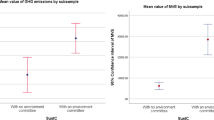Abstract
This study examines the effect of pollution control bonds on energy firms’ financial and environmental performance. A linear regression method was used for a sample of 221 U.S. energy firms observed from 2011 to 2020. The results indicate significant positive relationships between pollution control bonds and firm performance. Our results are robust to crisis effect and to alternative measures of firm performance and pollution control bonds. This study investigates the impact of pollution control bonds (PCBs) on the financial performance and environmental innovation of energy utility firms. Using a linear regression method, we analyzed a sample of 221 U.S. energy utility firms spanning from 2011 to 2020. The findings reveal significant positive effects of PCB issuance on both firm performance and environmental innovation. These results remain robust when considering crisis effects and alternative measures of both firm performance and environmental innovation. Notably, while existing literature has explored the outcomes of green financing, the specific benefits of PCBs have not been previously examined. The outcomes of this study hold valuable insights for regulators, investors, and policymakers aiming to advance the use of PCBs.

Source: Climate bonds initiative

Source: Climate bonds initiative

Source: Climate bond initiative

Source: Climate bond initiative

Source: Climate bond initiative
Similar content being viewed by others
Data availability
Data sharing is not applicable to this article as no new data were created or analyzed in this study.
References
Aastvedt, T. M., Behmiri, N. B., & Lu, L. (2021). Does green innovation damage financial performance of oil and gas companies. Resources Policy, 73, 102235.
Aldieri, L., Loppolo, L., Vinci, C. P., & Yagitcanlar, T. (2019). Waste recycling patents and environmental innovations: An economic analysis of policy instruments in the USA, Japan and Europe. Waste Management, 95, 612–619.
Amsden, A. H., & Chu, W. W. (2003). Beyond Late Development: Taiwan’s Upgrading Policies. MIT Press.
Arellano, M., & Bover, O. (1995). Another look at the instrumental-variable estimation of error-components models. Journal of Econometrics, 68, 29–52.
Arif, A., Vu, H. M., Ma, L. M., Monirul, I., & Gniewko, N. (2022). Natural resources commodity prices volatility and economic performance: Evaluating the role of green finance. Resources Policy, 76, 102557.
Bagirov, M., & Mateus, C. (2019). Oil prices, stock markets and firm performance: Evidence from Europe. International Review of Economics and Finance, 61, 270–288.
Bao, J., & He, M. (2022). Does green credit promote green sustainable development in regional economies?—Empirical evidence from 280 cities in China. PLoS ONE, 17(11), e0277569.
Blundell, R., & Bond, S. (1998). Initial conditions and moment restrictions in dynamic panel data models. Journal of Econometrics, 87(1), 115–143.
Buell, F. (2003). From apocalypse to way of life: Environmental crisis in the American Century. Routledge New York
Cheney, J. M., & Cossaboom, R. A. (1979). pollution control bonds (pcb): An appraisal and empirical study. Financial Review, 14, 25–25.
Delmar, F., McKelvie, A., & Wennberg, K. (2013). Untangling the relationships among growth, profitability and survival in new firms. Technovation, 33(8–9), 276–291.
Deschryver, P. (2020). Accélérer la transition énergétique : le rôle de la finance verte et ses enjeux pour l’Europe», Études de l’Ifri, https://www.ifri.org/sites/default/files/atoms/files/geg_finance_verte_avril2020_complet_okes.pdf
El-Kassar, A. B., & Singh, S. K. (2019). Green innovation and organozational performance: The influence of big data and the moderating role of management commitment and HR practices. Technological Forecasting and Social Change, 144, 483–498.
Flammer, C. (2021). Corporate green bonds. Journal of Financial Economics, in Press., 142(2), 499–516.
Freeman, R. E. (1984). Strategic management: A stakeholder approach. Pitman.
Friedman, R. (1976). Pollution Control Bonds: Developing Case Law in the States. Envtl. Aff., 5, 333.
Gasbarro, F., Rizzi, F., & Frey, M. (2016). Adaptation measures of energy and utility companies to cope with water scarcity induced by climate change. Business Strategy and the Environment, 25, 54–72.
Gonzalez, V. M. (2013). Leverage and corporate performance: International evidence. International Review of Economics & Finance, 25, 169–184.
Hale, J. (2021). A broken record : Les flux des fonds durables américains atteignent à nouveau de nouveaux sommets. Morningstar: Sustainability Matters. 28 janvier. https://www.morningstar.com/articles/1019195/abroken-record-flows-for-us-sustainable-funds-again-reach-new-height
He, L., Gan, S., & Zhong, T. (2022). The impact of green credit policy on firms’ green strategy choices: Green innovation or green-washing? Environmental Science and Pollution Research, 29, 73307–73325. https://doi.org/10.1007/s11356-022-20973-w
Hertenstein, J.H. Platt, M.B. Veryzer, R.W (2005). The impact of industrial effectiveness on corporate financial performance. Journal of Product Innovation Management, 22
Hu, G., Wang, X., & Wang, Y. (2021). Can green credit policy stimulate green innovation in heavily polluting enterprises Evidence from a quasi-natural experiment in China. Energy Economics, 98, 105134.
Jensen, M. C. (1986). Agency costs of free cash flow, corporate finance, and takeovers. American Economic Review, 76, 323–329.
Jo, H., Kim, H., & Park, K. (2015). Corporate environmental responsibility and firm performance in the financial services sector. Journal of Business Ethics, 131(2), 257–284.
Khanchel, I., & Lassoued, N. (2024). Is it hard to be different during the COVID-19 crisis? Investigating the relationship between corporate social responsibility and earnings management. International Journal of Ethics and Systems, 40(1), 17–44.
Khanchel, I., Lassoued, N., Bargaoui, I., et al. (2023a). Pollution control bonds and environmental performance in energy utility firms: Is there an incantation effect? International Journal of Energy Sector Management. https://doi.org/10.1108/IJESM-02-2023-0014
Khanchel, I., Lassoued, N., & Gargouri, R. (2023b). CSR and firm value: Is CSR valuable during the COVID 19 crisis in the French market? Journal of Management and Governance, 27, 575–601.
Khiari, C., Khanchel, I., & Lassoued, N. (2023). Does the sun ‘shine’ on utility firms? Evidence from pollution control bonds and overinvestment relationship. Journal of Financial Reporting and Accounting. https://doi.org/10.1108/JFRA-07-2023-0370
Krellenstein G.M (2012) Pollution control revenue, industrial development revenue, and conduit financing bonds. The handbook of Municipal Bonds.
Lassoued, Khanchel, I., & Khiari, C. (2024). Pollution control bonds and overinvestment in utility companies: Does ownership matter? Journal of Industrial and Business Economics (Forthcoming).
Lassoued, N., & Ben Osaman, I. (2021). The impact of national culture on overinvestment. International Journal of Revenue Management, 12, 3–4.
Lassoued, N., & Khanchel, I. (2021). Impact of COVID-19 on earnings management: An evidence from financial reporting in European firms. Global Business Review.
Lassoued, N., & Khanchel, I. (2023). Do green bonds alleviate environmental risk? Reference Module in Social Sciences. Elsevier. https://doi.org/10.1016/b978-0-44-313776-1.00133-1
Lassoued, N., Khanchel, I., & Fakhfakh, I. (2023). Bank efficiency in MENA countries: Does political connection type matter? Financial Innovation (Forthcoming).
Lee, C.-C., Wang, F., & Chang, Y.-F. (2023). Towards net-zero emissions: Can green bond policy promote green innovation and green space? Energy Economics, 121, 106675.
Liu, X., Wang, E., & Cai, D. (2019). Green credit policy, property rights and debt financing: Quasi-natural experimental evidence from China. Finance Research Letters, 29(2019), 129–135.
Loredo, E., Lopez-Mielgo, N., Pineiro-Villaverde, G. and García-Álvarez, M.T. (2019). Utilities: innovation and sustainability. Sustainability.
Maino, A. (2022). The role, opportunities and challenges of green bonds, Oxford Institute for Energy Studies.
Maltais, A. and Nykvist, B. (2020). Understanding the role of green bonds in advancing sustainability. Journal of Sustainable Finance and Investment.
McNichols, M. F. (2000). Research design issues in earnings management studies. Journal of Accounting and Public Policy, 19, 313–345.
Muganyi, T., Yan, L., & Sun, H. P. (2021). Green finance, fintech and environmental protection : Evidence from China. Environmental Science and Ecotechnology, 7(2021), 100107.
Olsen, M. C., Slotegraaf, R. J., & Chandukala, S. R. (2014). Green claims and message frames: how green new products change brand attitude. Journal of Marketing, 78, 5.
Ottoo, R. E. (2000). Valuation of Corporate growth opportunities-a real options approach. Garland Publishing, Inc, New York & London.
Owen, R., Brennan, G., & Lyon, F. (2018). Enabling investment for the transition toa low carbon economy: Government policy to finance early stage green innovation. Current Opinion in Environmental Sustainability, 31, 137–145.
Patten, D. M. (1992). Intra-industry environmental disclosures in response to the Alaskan oil spill: A note on legitimacy theory. Accounting, Organizations and Society, 17, 471–475.
Pham, L. (2016), Is it risky to go green? A volatility analysis of the green bond market. Journal of Sustainable Finance & Investment, 2016.
Reboredo, J. C., & Ugolini, A. (2020). Price connectedness between green bond and financial markets. Journal of Economic Modelling, 88(2020), 25–38.
Refinitiv (2020). Environmental, social and governance (ESG) scores from refinitiv, available at: https://www.refinitiv.com/content/dam/marketing/en_us/documents/methodology/refinitiv-esg-scores-methodology.pdf. Accessed 07 October 2022.
Roberts, J.J., Croke, E.J., Booras, S. (1975) A critical review of air pollution control regulations on land use planning. Journal of the Air Pollution Control Association, p 500–520.
Robins, N Clover, R Singh C. (2009). A Climate for Recovery: The Color of Stimulus goes Green HSBC Global Research (2009) Available in https://www.globaldashboard.org/wp-content/uploads/2009/HSBC_Green_New_Deal.pdf
Sachs, J.D., Woo, W.T., Yoshino, N. and Taghizadeh-Hesary, F. (2019). “Why Is Green Finance Important?, ADBI Working Paper Series. No. 917, Asian Development Bank Institute, Tokyo.
Schiessl, D., Korelo, J. C., & Cherobim, A. P. (2022). Corporate social responsibility and the impact on economic value added : the role of environmental innovation. European Business Review, 34(33), 396–410.
Su, D., & Lian, L. (2018). Does green credit policy affect corporate financing and investment? Evidence from publicly listed firms in pollution-intensive industries. Journal of Financial Research, 12, 123–137.
Sun, J., Wang, F., Yin, H., & Zhang, B. (2019). Money talks: the environmental impact of china’s green credit policy. Journal of Policy Analysis and Management, 38(3), 653–680.
Sun, H., Tarik, G., Youn, I. J., & Mansoor, S. (2022). Impacts of green energy finance on eco-friendly environments. Resources Policy, 79, 103135.
Tang, D. Y., & Zhang, Y. (2020). Do shareholders benefit from green bonds? Journal of Corporate Finance, 61, 101427. https://doi.org/10.1016/j.jcorpfin.2020.101427
Ullman, A. (1985). Data in search of a theory: a critical examination of the relationship among social performance, social disclosure and economic performance. Academy of Management Review, 10(3), 540–577.
Wang, T., Liu, X., & Wang, H. (2022). Green bonds, financing constraints, and green innovation. Journal of Cleaner Production, 381(1), 135134.
Weber, O. (2017). Corporate sustainability and financial performance of Chinese banks. Sustainability Accounting, Management and Policy Journal, 8(3), 358–385.
Westmeyer, T. R., & Westmeyer, W. (1974). Pollution control bonds increase. National Civic Review, 63(3), 151–155.
Yeow, K., & Ng, S. (2021). The impact of green bonds on corporate environmental and financial performance. Managerial Finance, 47(10), 1486–1510.
Zhang, Y. (2022). How economic performance of OECD economies influences through green finance and renewable energy investment resources? Resources Policy, 79(2022), 102925.
Zhang, Y., Xing, C., & Wang, Y. (2020). Does green innovation mitigate financing constraints? Evidence from China’s private enterprises. Journal of Cleaner Production, 264, 121698. https://doi.org/10.1111/jifm.12153
Zhou, X., & Cui, Y. (2019). Green bonds, corporate performance, and corporate social responsibility. Sustainability, 11(23), 6881.
Acknowledgements
The authors are grateful to the anonymous referees of the journal for their extremely useful suggestions to improve the quality of the article. Usual disclaimers apply.
Funding
The authors disclosed receipt of the following financial support for the research, authorship, and/or publication of this article.
Author information
Authors and Affiliations
Contributions
IB contributed to data curation and writing. IK contributed to conceptualization, theoretical background, and editing. NL contributed to conceptualization, empirical design, and writing.
Corresponding author
Ethics declarations
Conflict of interest
The authors declared no potential conflicts of interest with respect to the research, authorship, and/or publication of this article.
Additional information
Publisher's Note
Springer Nature remains neutral with regard to jurisdictional claims in published maps and institutional affiliations.
Rights and permissions
Springer Nature or its licensor (e.g. a society or other partner) holds exclusive rights to this article under a publishing agreement with the author(s) or other rightsholder(s); author self-archiving of the accepted manuscript version of this article is solely governed by the terms of such publishing agreement and applicable law.
About this article
Cite this article
Bargaoui, I., Khanchel, I. & Lassoued, N. Are pollution control bonds the solution for energy firms under the magnifying glass?. Environ Dev Sustain (2024). https://doi.org/10.1007/s10668-023-04441-0
Received:
Accepted:
Published:
DOI: https://doi.org/10.1007/s10668-023-04441-0




